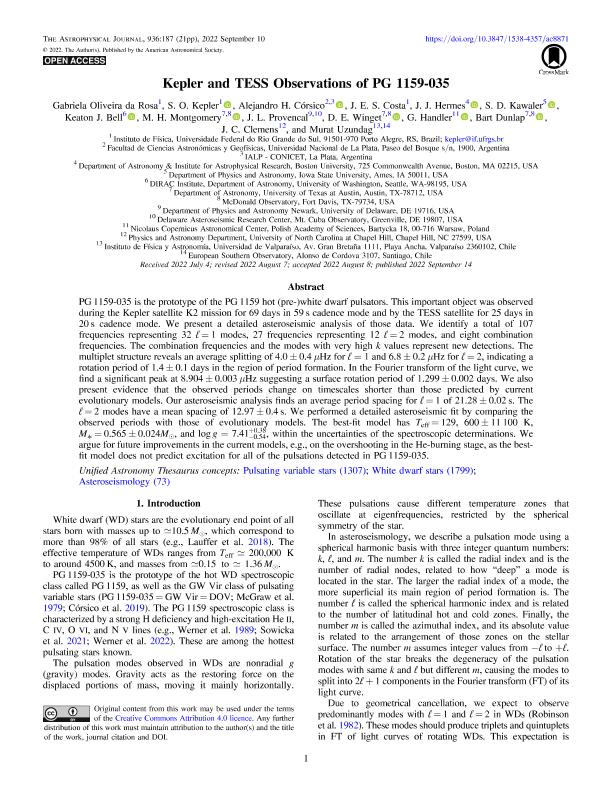Artículo
Kepler and TESS Observations of PG 1159-035
Oliveira da Rosa, Gabriela; Kepler, S. O.; Corsico, Alejandro Hugo ; Costa, J. E. S.; Hermes, J. J.; Kawaler, S. D.; Bell, Keaton J.; Montgomery, M. H.; Provencal, J. L.; Winget, D. E.; Handler, G.; Dunlap, Bart; Clemens, J. C.; Uzundag, Murat
; Costa, J. E. S.; Hermes, J. J.; Kawaler, S. D.; Bell, Keaton J.; Montgomery, M. H.; Provencal, J. L.; Winget, D. E.; Handler, G.; Dunlap, Bart; Clemens, J. C.; Uzundag, Murat
 ; Costa, J. E. S.; Hermes, J. J.; Kawaler, S. D.; Bell, Keaton J.; Montgomery, M. H.; Provencal, J. L.; Winget, D. E.; Handler, G.; Dunlap, Bart; Clemens, J. C.; Uzundag, Murat
; Costa, J. E. S.; Hermes, J. J.; Kawaler, S. D.; Bell, Keaton J.; Montgomery, M. H.; Provencal, J. L.; Winget, D. E.; Handler, G.; Dunlap, Bart; Clemens, J. C.; Uzundag, Murat
Fecha de publicación:
09/2022
Editorial:
IOP Publishing
Revista:
Astrophysical Journal
ISSN:
0004-637X
Idioma:
Inglés
Tipo de recurso:
Artículo publicado
Clasificación temática:
Resumen
PG 1159-035 is the prototype of the PG 1159 hot (pre-)white dwarf pulsators. This important object was observed during the Kepler satellite K2 mission for 69 days in 59 s cadence mode and by the TESS satellite for 25 days in 20 s cadence mode. We present a detailed asteroseismic analysis of those data. We identify a total of 107 frequencies representing 32 ℓ = 1 modes, 27 frequencies representing 12 ℓ = 2 modes, and eight combination frequencies. The combination frequencies and the modes with very high k values represent new detections. The multiplet structure reveals an average splitting of 4.0 ± 0.4 μHz for ℓ = 1 and 6.8 ± 0.2 μHz for ℓ = 2, indicating a rotation period of 1.4 ± 0.1 days in the region of period formation. In the Fourier transform of the light curve, we find a significant peak at 8.904 ± 0.003 μHz suggesting a surface rotation period of 1.299 ± 0.002 days. We also present evidence that the observed periods change on timescales shorter than those predicted by current evolutionary models. Our asteroseismic analysis finds an average period spacing for ℓ = 1 of 21.28 ± 0.02 s. The ℓ = 2 modes have a mean spacing of 12.97 ± 0.4 s. We performed a detailed asteroseismic fit by comparing the observed periods with those of evolutionary models. The best-fit model has T eff = 129, 600 ± 11 100 K, M * = 0.565 ± 0.024M ⊙, and log g = 7.41 − 0.54 + 0.38 , within the uncertainties of the spectroscopic determinations. We argue for future improvements in the current models, e.g., on the overshooting in the He-burning stage, as the best-fit model does not predict excitation for all of the pulsations detected in PG 1159-035.
Palabras clave:
Pulsating variable stars
,
White dwarf stars
,
Asteroseismology
Archivos asociados
Licencia
Identificadores
Colecciones
Articulos(IALP)
Articulos de INST.DE ASTROFISICA LA PLATA
Articulos de INST.DE ASTROFISICA LA PLATA
Citación
Oliveira da Rosa, Gabriela; Kepler, S. O.; Corsico, Alejandro Hugo; Costa, J. E. S.; Hermes, J. J.; et al.; Kepler and TESS Observations of PG 1159-035; IOP Publishing; Astrophysical Journal; 936; 2; 9-2022; 1-21
Compartir
Altmétricas



